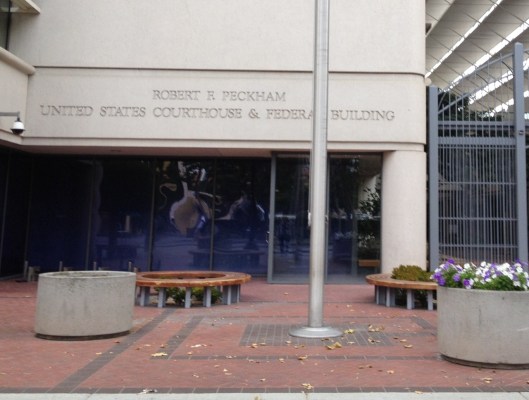We’re just commencing Week Two of the Samsung v. Apple trial in San Jose, and Judge Lucy Koh opened the day with a joke, saying that there had been a false hope in her heart this weekend that the two would settle. But these two electronics giants are still ready to battle it out, and have brought Justin Denison, Samsung’s Chief Strategy officer, back to the stand.
After some questions about whether or not STA sells directly to consumers, and whether Galaxy phones are different from one model to the next, Samsung’s lawyer Mr. Quinn was about to actually make a point.
He mentioned that throughout the trial, there have been comments such as “Samsung is in a crisis of design” and “the difference between the iPhone and the Galaxy phones are like heaven and earth.”
Since Apple’s asserting that four of its design patents and one trade dress registration were infringed, any proof that Samsung was trying to copy either specific patented features or general Apple-esque aesthetic in its handsets would be damaging to Samsung’s case. While mention of a crisis of design don’t prove conscious copying, it could certainly push the jury to believe Samsung was letting competition from the iPhone affect design choices.
Quinn then laid out a series of questions, asking about Samsung’s general “style of communication for management to motivate employees.” Denison answered with the following:
Samsung does an excellent job of remaining very humble, self critical, and maintaining a sense of urgency within its own ranks to drive hard work and innovation. We want to change so that [Samsung] never rests on its laurels and becomes complacent. So you hear a lot of hyperbolic statements, “crisis of design,” “heaven and earth.”
Quinn then asked if there are any graphic examples of this type of communication within Samsung, which felt like a small win on the horizon when Denison brought up a famous story within Samsung. He unfortunately also mentioned that he wasn’t there for this, and had only heard about it, allowing Apple counsel to object on the basis of hearsay and have any comment on other graphic examples of hyperbolic communication overruled and thrown out.
Mr. Quinn then asked how Denison felt about Apple’s accusations that Samsung had “ripped off” Apple’s designs, a phrase Apple has hammered home since the trial’s very beginning.
I find it very offensive. At Samsung, we’re very proud of the products we produced, of all the hard work that goes into bringing a product to market. We’ve been in the mobile business for 20 years globally, been in the U.S. for 15 years, and for the last four years we’ve been number 1 in the U.S. market. What we would like to be able to do is just compete in the market and continue doing what we’re doing.
Denison listed certain features that Samsung had added to its phones before Apple, such as voice recognition/voice command capabilities, advanced screen tech (Super AMOLED), and cloud video services. Quinn asked Denison if he felt like Apple ripped off Samsung when Cupertino included these features in their own devices, to which Denison responded that he didn’t feel ripped off or outraged the same way Apple has felt during the course of this cases.
“If Apple comes out with the iPhone 5 and it has a bigger scree, more like the size of the Galaxy S II screen, will you regard that as copying?” asked Mr. Quinn. And right as rain, Denison answered no.
Then Apple’s lawyer, Mr. Lee, stood to cross-examine. He mentioned an internal Samsung investigation before the trial, and asked Denison if he’d seen any documents wherein Samsung mentions a “crisis of design” with regards to Apple’s iPhone. “I can’t recall,” said Denison. “There are many documents I see in preparation for this testimony and testimony in other cases.”
Lee then “refreshed his recollection,” bringing up a document that stated the following: “It is a crisis of design. The iPhone’s emergence means that the time we have to change our methods has arrived.”
And then Lee pointed to another internal document: “All this time we’ve been paying all our attention to Nokia and concentrated our efforts on things like Folders, Bars and Slide, yet when our UX is compared to the unexpected competitor Apple iPhone, the difference is truly that of heaven and earth. It’s a crisis of design.”
Denison explained again that this is a typical type of hyperbolic statement you’d hear within Samsung.
“So can you provide documents where Samsung has said the same types of things about Nokia?” asked Lee.
“I am not sure how I’d do that,” responded Denison.
“The answer is that you can’t,” said Lee. “The only mention of ‘crisis of design’ in all of Samsung’s documents is in reference to Apple after the iPhone’s introduction in 2007.”
On Friday, he went toe to toe with Apple’s lawyers who threw out internal documents that show Samsung’s purposefully trying to tweak the home screen layout of their phones to differentiate from Apple. “Remove a feeling that iPhone’s menu icons are copied by differentiating design” as one of the “directions for improvement,” it read. Denison, however, did a great job combating this once approached by Samsung counsel, explaining that rounded corners, slim bezels and fully touchscreen candy bar handsets were more of a necessity and a general direction of the industry rather than a design choice.
